‘BULGAR TIME’
by Anne Marie
Huibregtse
|
|
|
|
|
|
|
|
Around 1978 Viktor / Bulgar became
enthusiastically involved with clocks.
He thought that it was time to end the age-old way in
which we indicate and read the time from our clocks and
watches. It started with the dial of a clock in a bar,
from which he had removed the six and regularly divided
the other numbers, so that at first sight everything
seemed normal. But visitors to the café who had a few
drinks after work, became strangely confused when it
came to establishing the time to go home.
Viktor called this new activity 'Bulgar Time'.
('In the beginning was the idea that the number six has
carried or supported the number hierarchy of the twelve
hours for many centuries and thus deserved a vacation
from its duties stoking coal into the boilers down at
the bottom of the cruise ship with all the rest of the
numbers danced merrily above…' as Viktor put it)
The next step (in 1980) was to
design a clock with hands turning in the opposite
way. The 6 reappeared, but the clock dial was turned
upside down, so that the 6 appeared at the top and
the 12 at the bottom.
In September 1981, after many trips to Switzerland
together with Ina in his old black Citroën deux
chevaux, at last the first prototype of the Bulgar
Time Swiss Quartz wristwatch was manufactured. A long
series of different models, including watches running
at double or triple speed even, was to appear over
the years.
First they were sold by Viktor himself, but finally
(in 1986, shortly before his death), the four models
he considered as definitive were put on the market by
Art Expo, Odense, Denmark, in a limited edition, in a
black box with accompanying book 'The Time Is Always
Now'. www.artandphoto.dk
|

|
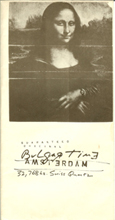
|
|
|
|
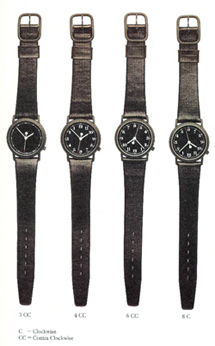
|
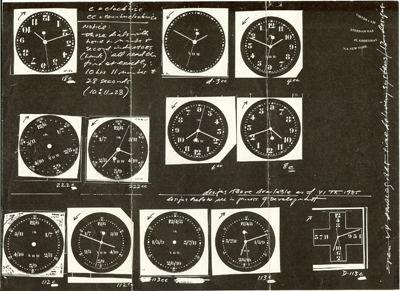
|
|
|
|
|
|
|
C = Clockwise, CC =
Counterclockwise. Notice: these dials with hour +
minute + second indicators (hands) all read the time at
exactly: 10 hrs 11 minutes and 28 seconds (10:
11.28)
|
|
Photo: On all watches the
time is 8 minutes past 10
|
|
|
|
|
|
Unexpected end
Viktor IV was still very active when, on June 26th 1986
at the age of 57, he drowned in the Amstel River while
repairing the rafts.
His last trip by boat over the Amstel to the cemetery
of Zorgvlied on the warm and sunny 3rd of July
attracted thousands of sympathizers along the
water-front and on the bridges, and dozens of boats
escorted his funeral on the water.
|
|
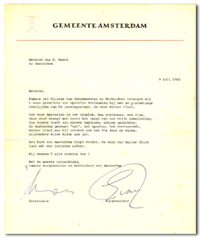
|
Letter from the Mayor
Amsterdam's mayor Ed van Thijn,
wrote in a letter of condolence to Ina: 'For Amsterdam
as well, his accident has come as a blow. Our city is
proud to carry the image of a free society, allowing
new impulses, new thoughts. In Amsterdam 'it' happens,
the playful, the unexpected. Walter Glück was by all
means a man who contributed in his own unique and
colorful way. The heart of Amsterdam goes on beating.
Yet the death of Walter Glück leaves a scar.'
|
|
|
|
|
|
|
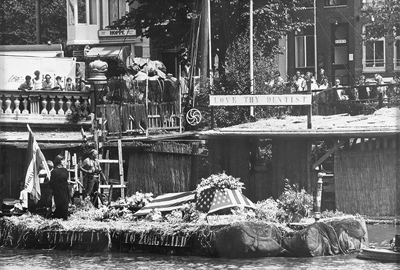
|
|
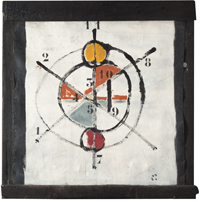
|
|
|
|
|
Funeral
When Viktor's old aunt, 'Aunt
Fani', who lived at the time in an old people's home in
Florida, saw the newspaper cuttings with the photos of
the enormous crowd at the obsequies, she must have
exclaimed: "A royal funeral? What happened to our
Walter?"
Twan Huys (journalist and tv
presenter) remembers: "As far as I am concerned it
was the most impressive funeral I have ever seen. A
flotilla of small boats, water bikes and rubber boats
on the Amstel River. Viktor IV is dead, he got a
royal funeral with an anarchistic flair. With the
American flag on his coffin and the text "VIKTOR IV
TO ZORGVLIED" he slowly plies the Amstel River. An
unforgettable end, only in Amsterdam".
|
|
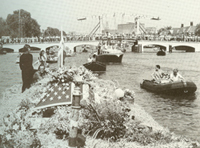
|
|
|
|
|
|
Ref: Viktor IV. Ad Petersen
& Ina Munck. Ed. Meulenhoff/Landshoff & The
Second Quality Construction Company 1988
|